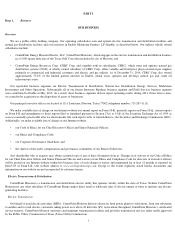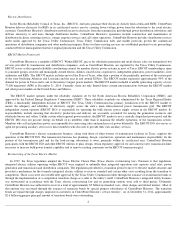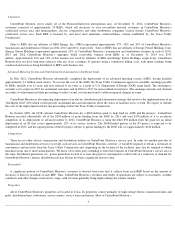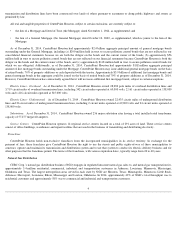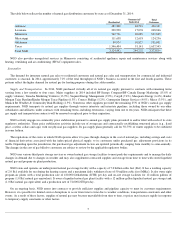CenterPoint Energy 2014 Annual Report Download - page 16
Download and view the complete annual report
Please find page 16 of the 2014 CenterPoint Energy annual report below. You can navigate through the pages in the report by either clicking on the pages listed below, or by using the keyword search tool below to find specific information within the annual report.
For a discussion of certain of CenterPoint Houston’s ongoing regulatory proceedings, see “Management’
s Discussion and Analysis of
Financial Condition and Results of Operations — Liquidity and Capital Resources — Regulatory Matters — CenterPoint Houston”
in Item 7 of
Part II of this report, which discussion is incorporated herein by reference.
State and Local Regulation – Natural Gas Distribution
In almost all communities in which NGD provides natural gas distribution services, it operates under franchises, certificates or licenses
obtained from state and local authorities. The original terms of the franchises, with various expiration dates, typically range from 10 to 30 years,
although franchises in Arkansas are perpetual. NGD expects to be able to renew expiring franchises. In most cases, franchises to provide natural
gas utility services are not exclusive.
Substantially all of NGD is subject to cost-of-
service rate regulation by the relevant state public utility commissions and, in Texas, by the
Railroad Commission of Texas (Railroad Commission) and those municipalities served by NGD that have retained original jurisdiction. In
certain of its jurisdictions, NGD has in effect annual rate adjustment mechanisms that provide for changes in rates dependent upon certain
changes in invested capital, earned returns on equity or actual margins realized.
For a discussion of certain of NGD’s ongoing regulatory proceedings, see “Management’
s Discussion and Analysis of Financial Condition
and Results of Operations — Liquidity and Capital Resources — Regulatory Matters — CERC”
in Item 7 of Part II of this report, which
discussion is incorporated herein by reference.
Department of Transportation
In December 2006, Congress enacted the Pipeline Inspection, Protection, Enforcement and Safety Act of 2006 (2006 Act), which
reauthorized the programs adopted under the Pipeline Safety Improvement Act of 2002 (2002 Act). These programs included several
requirements related to ensuring pipeline safety, and a requirement to assess the integrity of pipeline transmission facilities in areas of high
population concentration.
Pursuant to the 2006 Act, the Pipeline and Hazardous Materials Safety Administration (PHMSA) at the Department of Transportation
(DOT) issued regulations, effective February 12, 2010, requiring operators of gas distribution pipelines to develop and implement integrity
management programs similar to those required for gas transmission pipelines, but tailored to reflect the differences in distribution pipelines.
Operators of natural gas distribution systems were required to write and implement their integrity management programs by August 2, 2011. Our
natural gas distribution systems met this deadline.
Pursuant to the 2002 Act and the 2006 Act, PHMSA has adopted a number of rules concerning, among other things, distinguishing between
gathering lines and transmission facilities, requiring certain design and construction features in new and replaced lines to reduce corrosion and
requiring pipeline operators to amend existing written operations and maintenance procedures and operator qualification programs. PHMSA also
updated its reporting requirements for natural gas pipelines effective January 1, 2011.
In December 2011, Congress passed the Pipeline Safety, Regulatory Certainty, and Job Creation Act of 2011 (2011 Act). This act increases
the maximum civil penalties for pipeline safety administrative enforcement actions; requires the DOT to study and report on the expansion of
integrity management requirements and the sufficiency of existing gathering line regulations to ensure safety; requires pipeline operators to
verify their records on maximum allowable operating pressure; and imposes new emergency response and incident notification requirements.
We anticipate that compliance with PHMSA’s regulations, performance of the remediation activities by CERC’
s natural gas distribution
companies and verification of records on maximum allowable operating pressure will require increases in both capital expenditures and
operating costs. The level of expenditures will depend upon several factors, including age, location and operating pressures of the facilities. In
particular, the cost of compliance with DOT’
s integrity management rules will depend on integrity testing and the repairs found to be necessary
by such testing. Changes to the amount of pipe subject to integrity management, whether by expansion of the definition of the type of areas
subject to integrity management procedures or of the applicability of such procedures outside of those defined areas, may also affect the costs we
incur. Implementation of the 2011 Act by PHMSA may result in other regulations or the reinterpretation of existing regulations that could impact
our compliance costs. In addition, we may be subject to DOT’
s enforcement actions and penalties if we fail to comply with pipeline regulations.
Please also see the discussion under “— Midstream Investments — Safety and Health Regulation” below.
10


